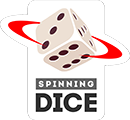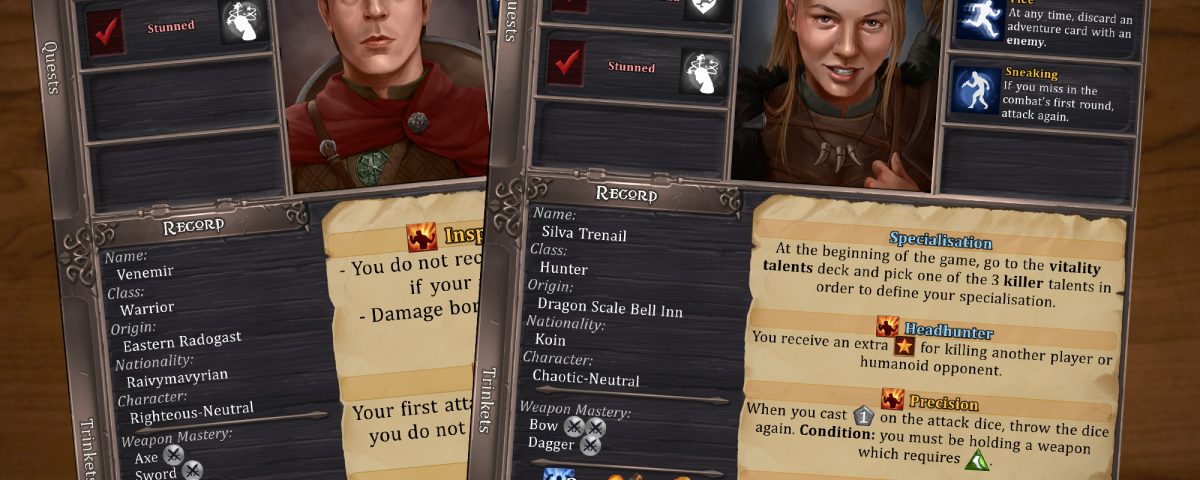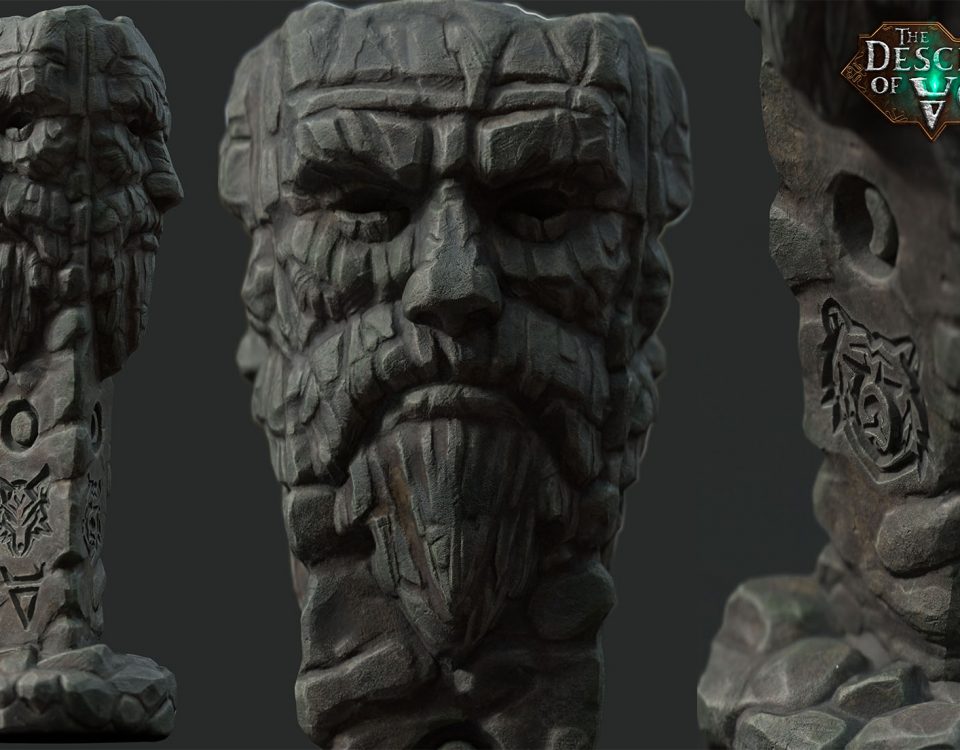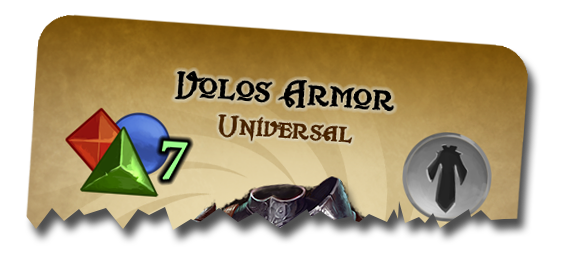Setting up a player character

Dungeons
11 December 2018
Character Portraits
15 September 2019Welcome in a new Development Diary post of the adventure game – The Descendants of Volos!
If you haven’t read the previous posts yet, here they are:
Post 1 – Game announcement
Post 2 – World map and Tutorial
Post 3 – Event cards
Post 4 – Equipment
Post 5 – Enemies and Combat
Post 6 – Dungeons
Character setup
In the Descendants of Volos board game, you play as one of several characters included in the game content. Every character is set on a decent-size thick paper, where all skills and character details are stored. Today, we’ll use some content from the tutorial book to talk about your character and how to set it up.
So, here are some slides from the Tutorial’s “Setting up a character” chapter:
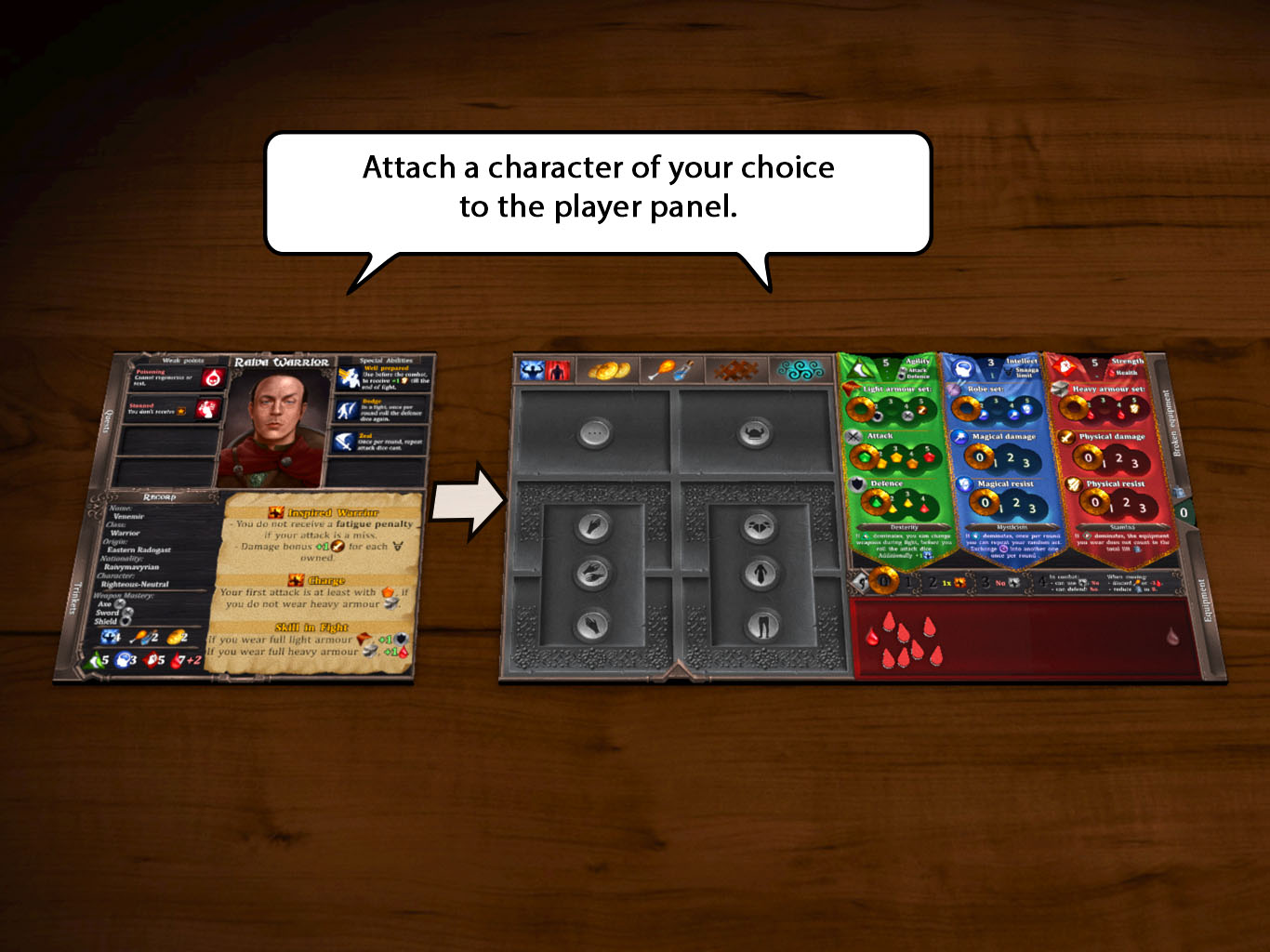
On the left, you can see the “character card”. Those are unique for every character you choose. On the right you have the “player panel”, those are the same for everyone.
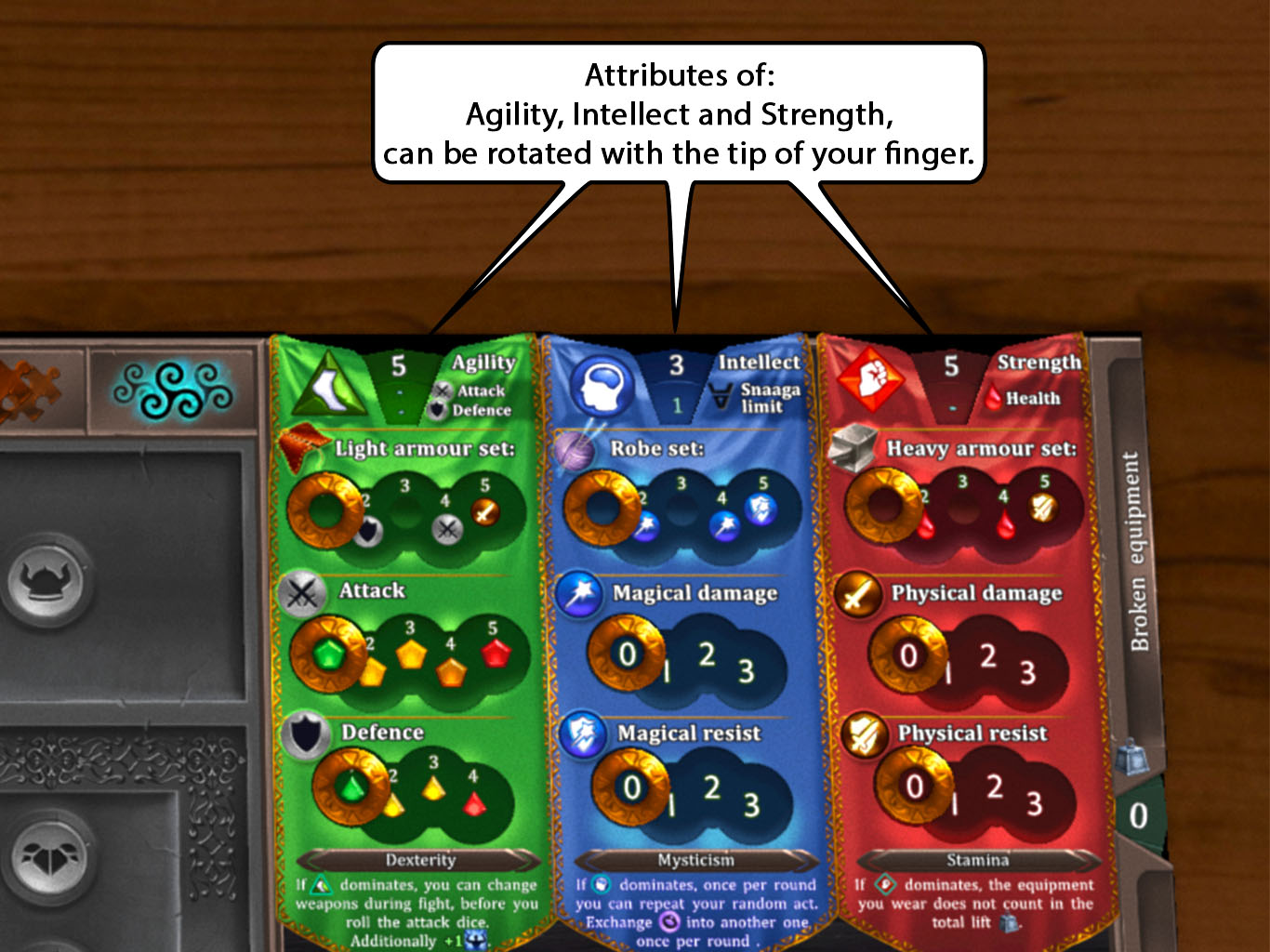
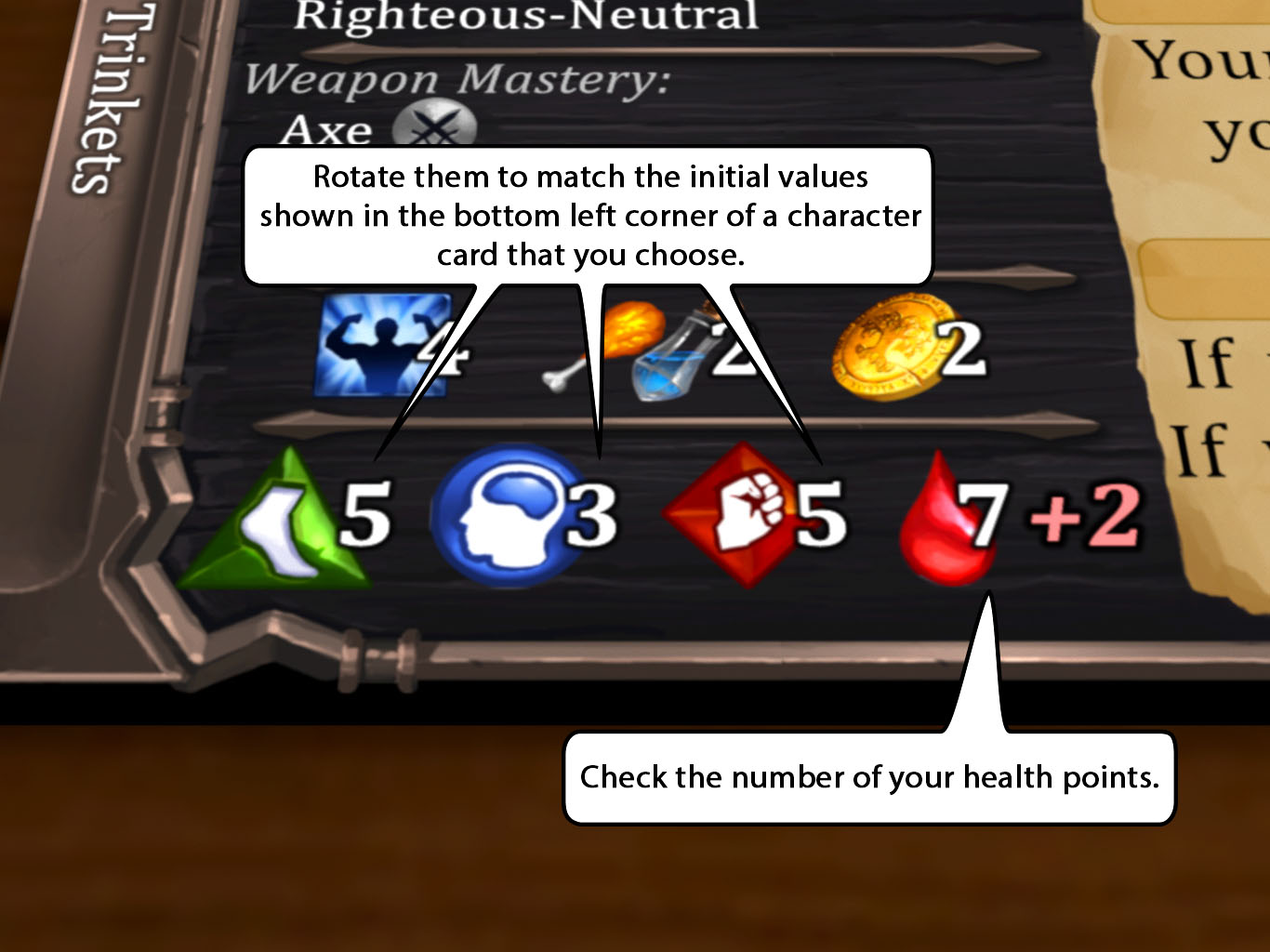
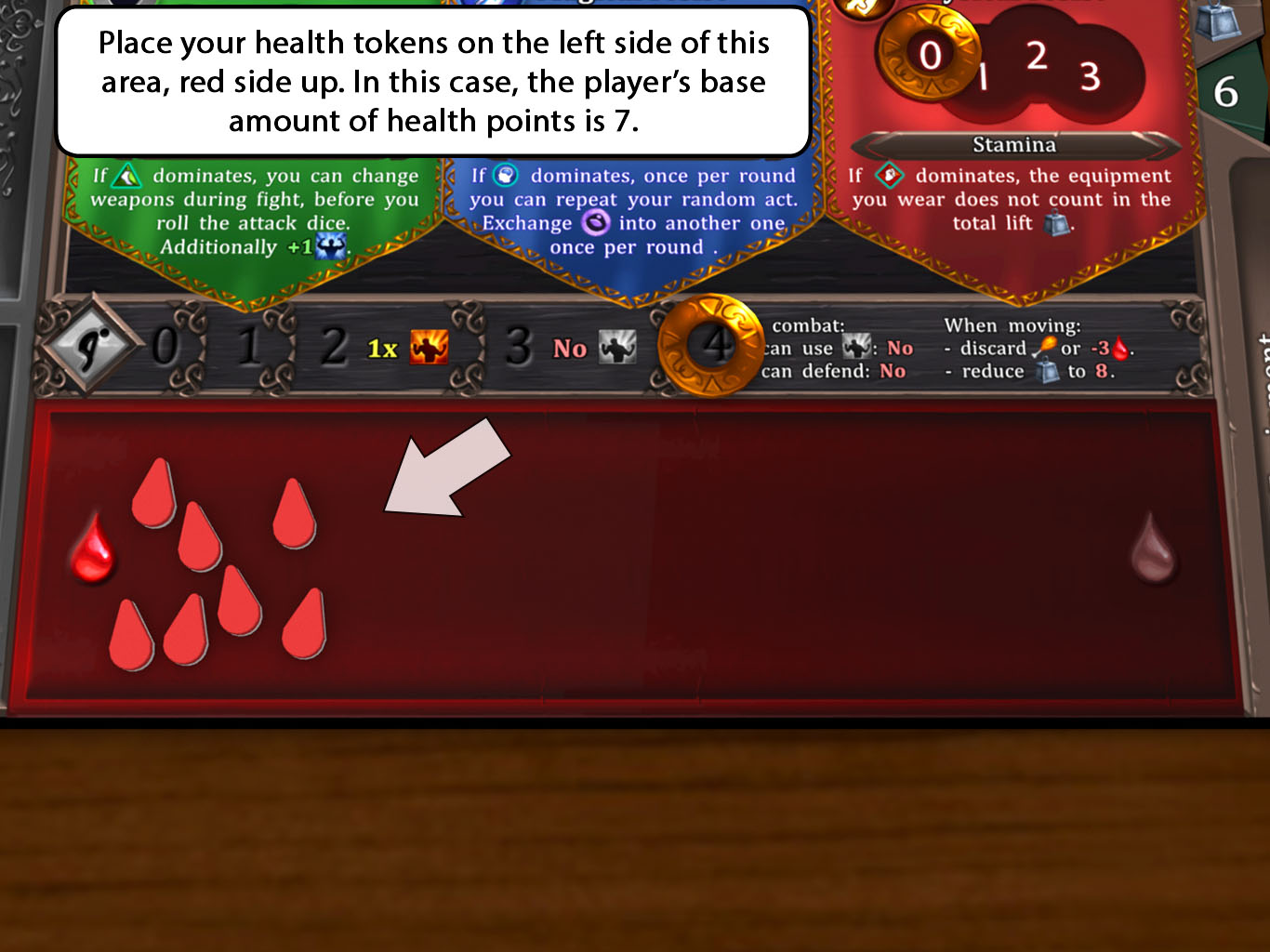
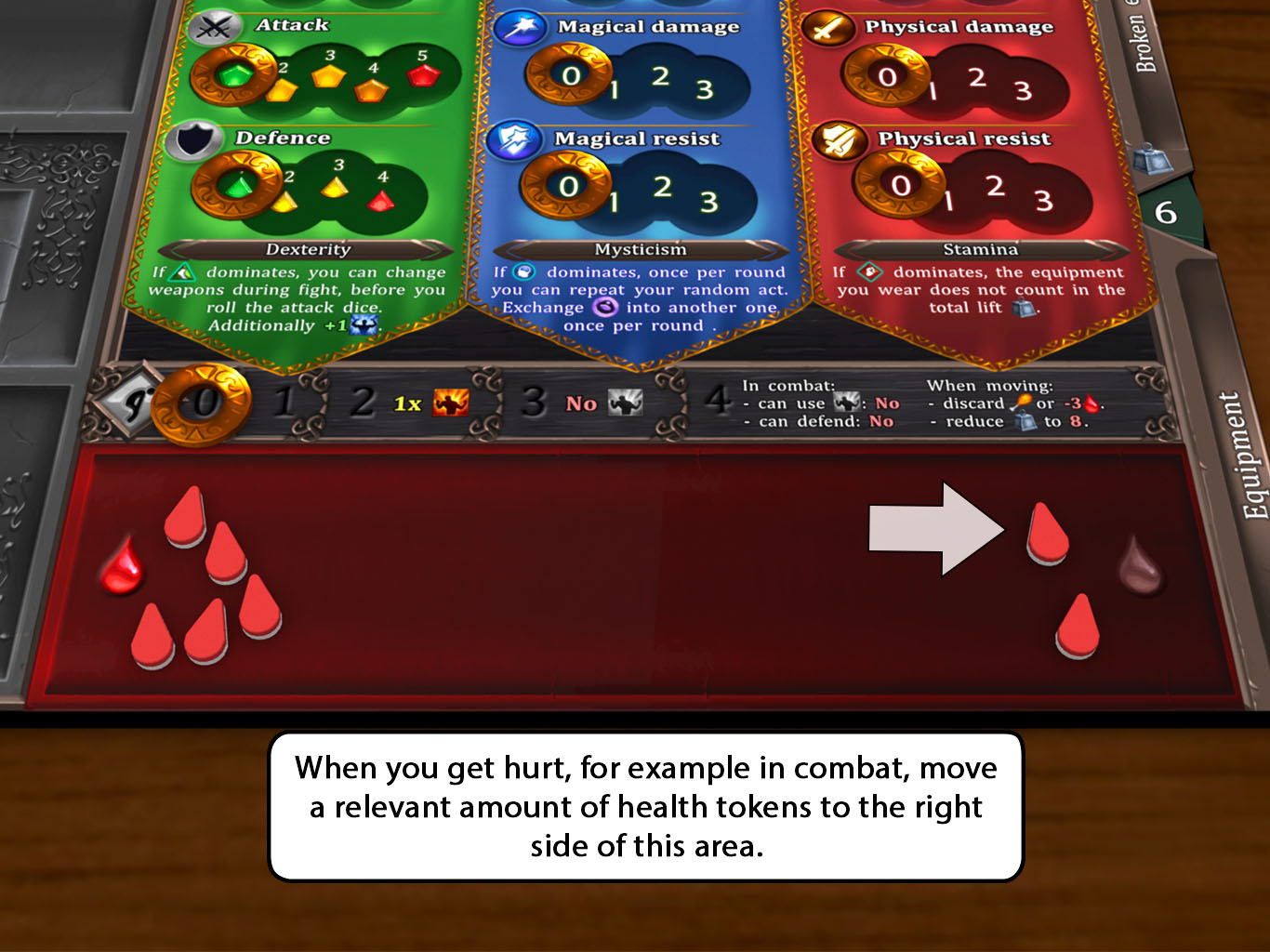
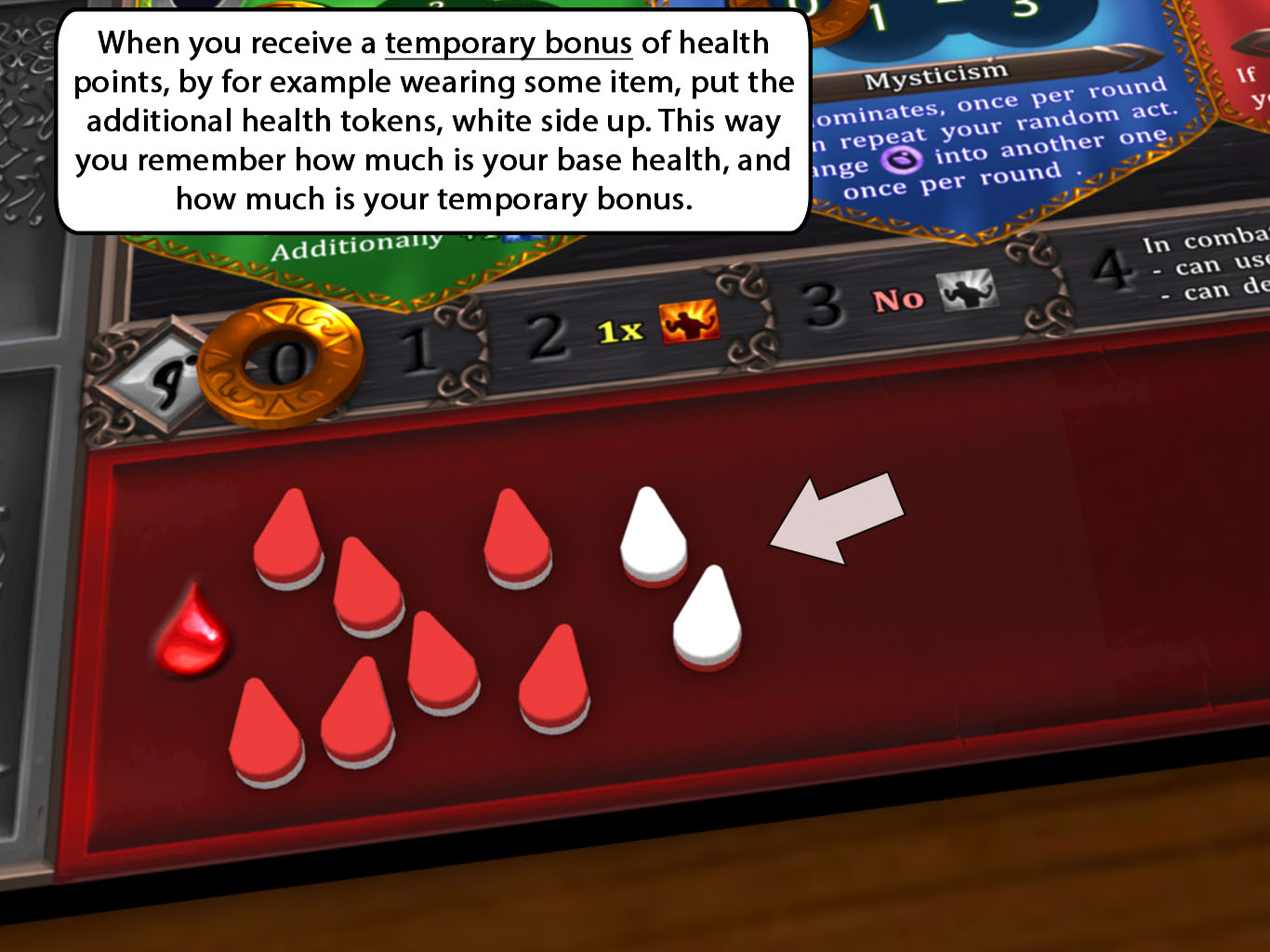
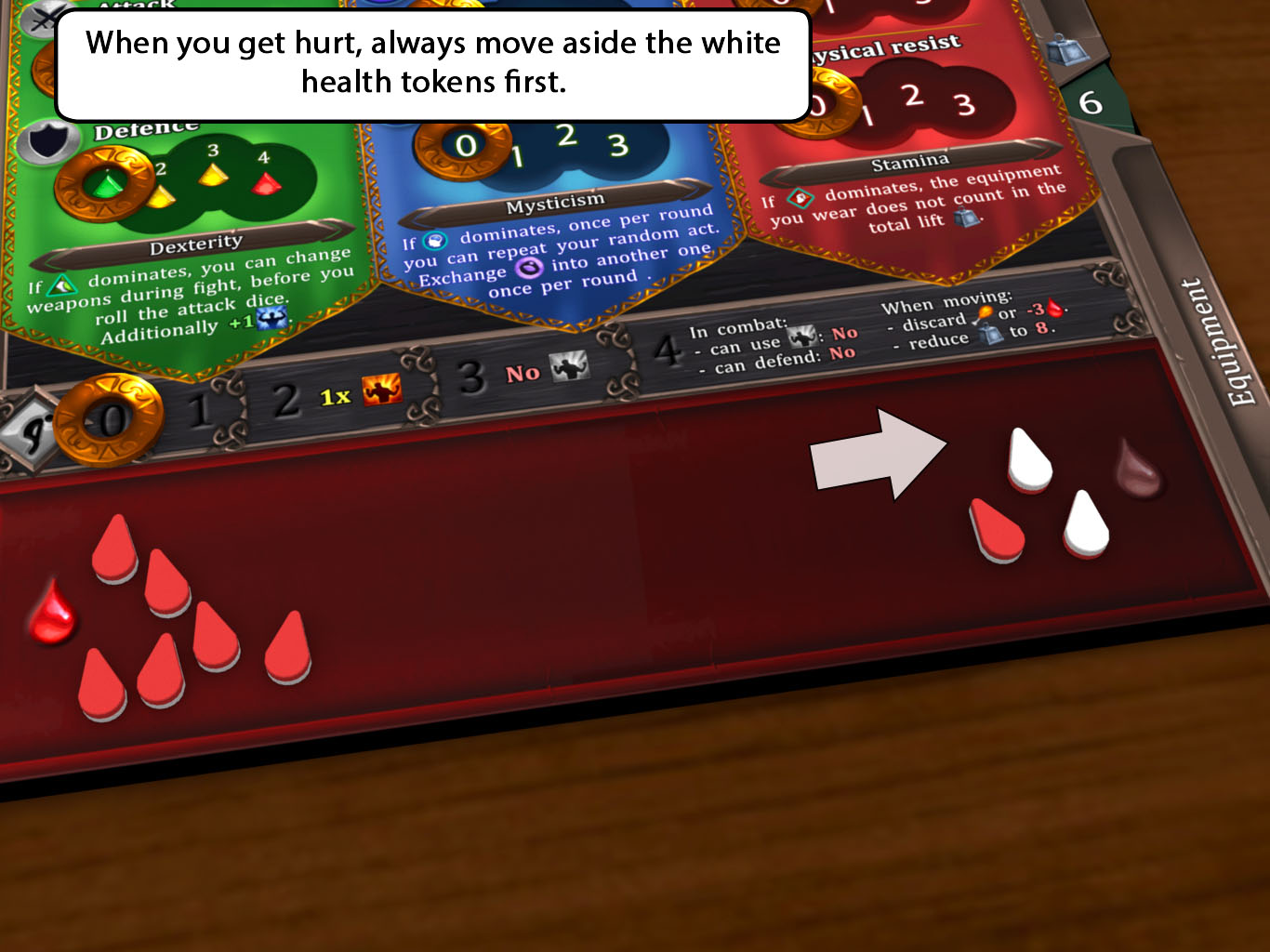
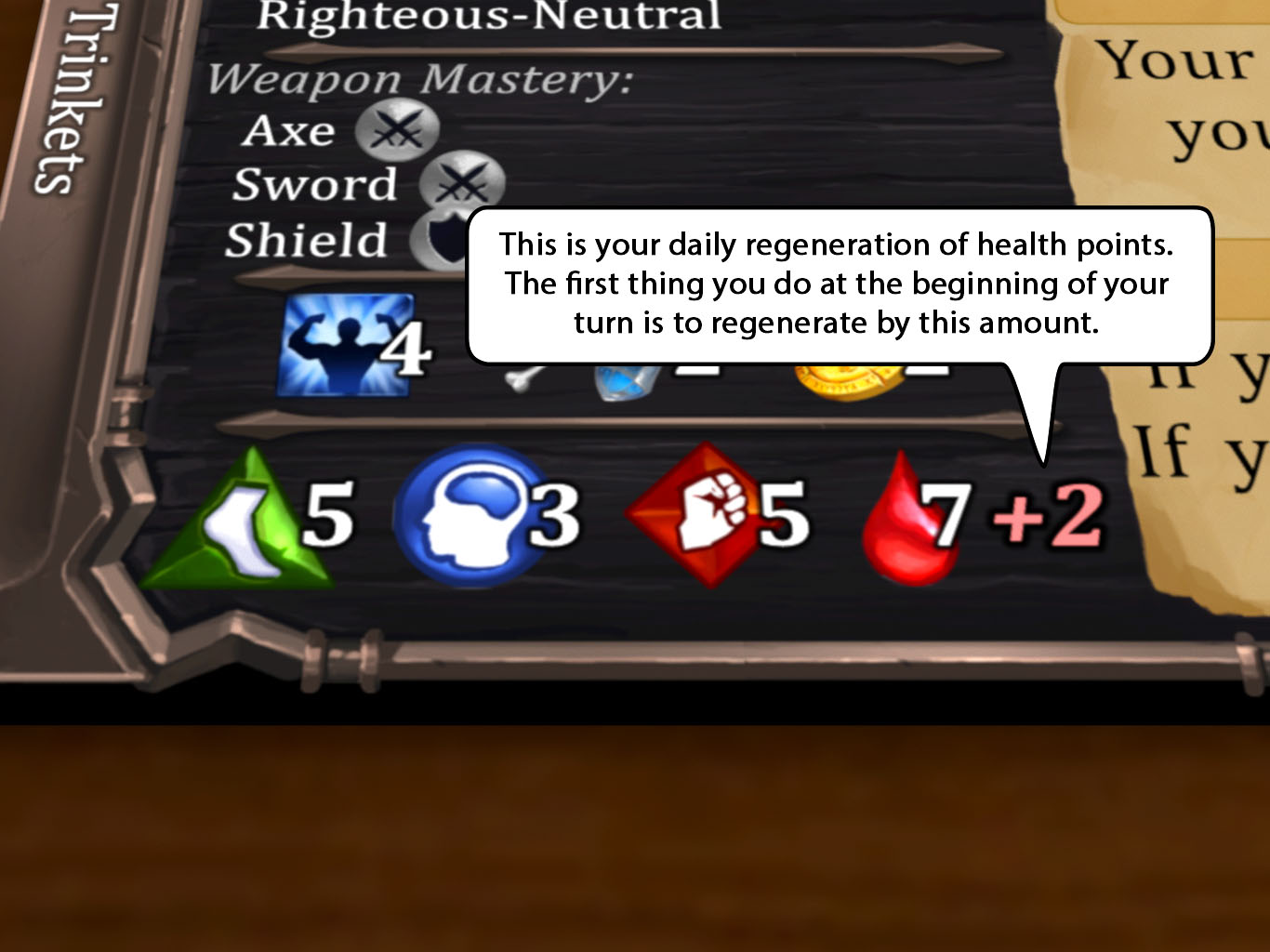
In the above slides, we explained how to setup the initial number of health points, and how to use them. If you’ve been tracking our previous posts, you may have noticed that the bottom right part of the “player panel” evolved a few times, and in this version it evolved once again. After having many discussions and collecting many opinions, we’ve finally opted for a solution in which each health token represents 1 health point. For tracing the health of the enemies we have a different solution, which also evolved a lot and which we’ll mention in the future development diary post.
Let’s continue with setting up…
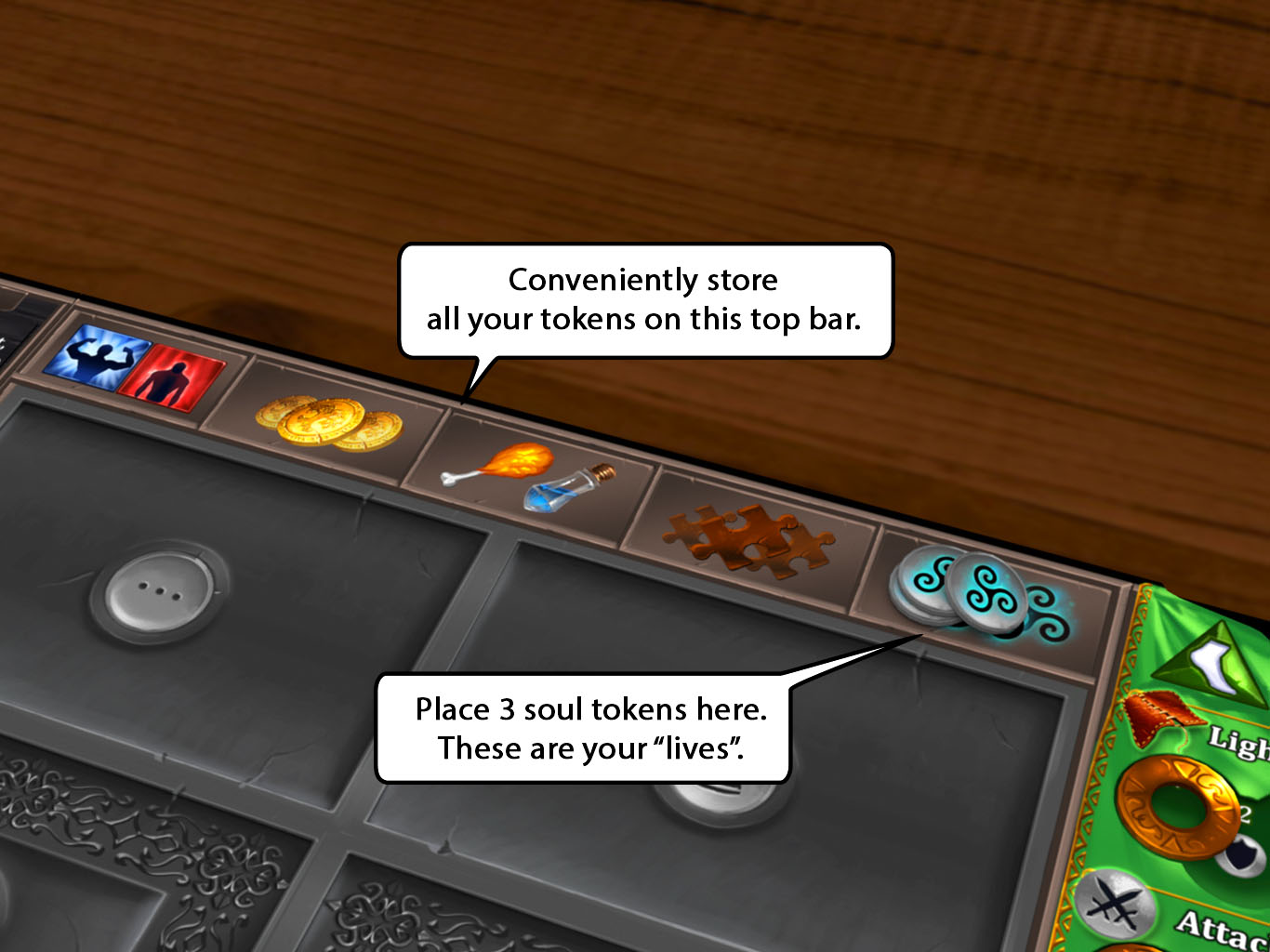
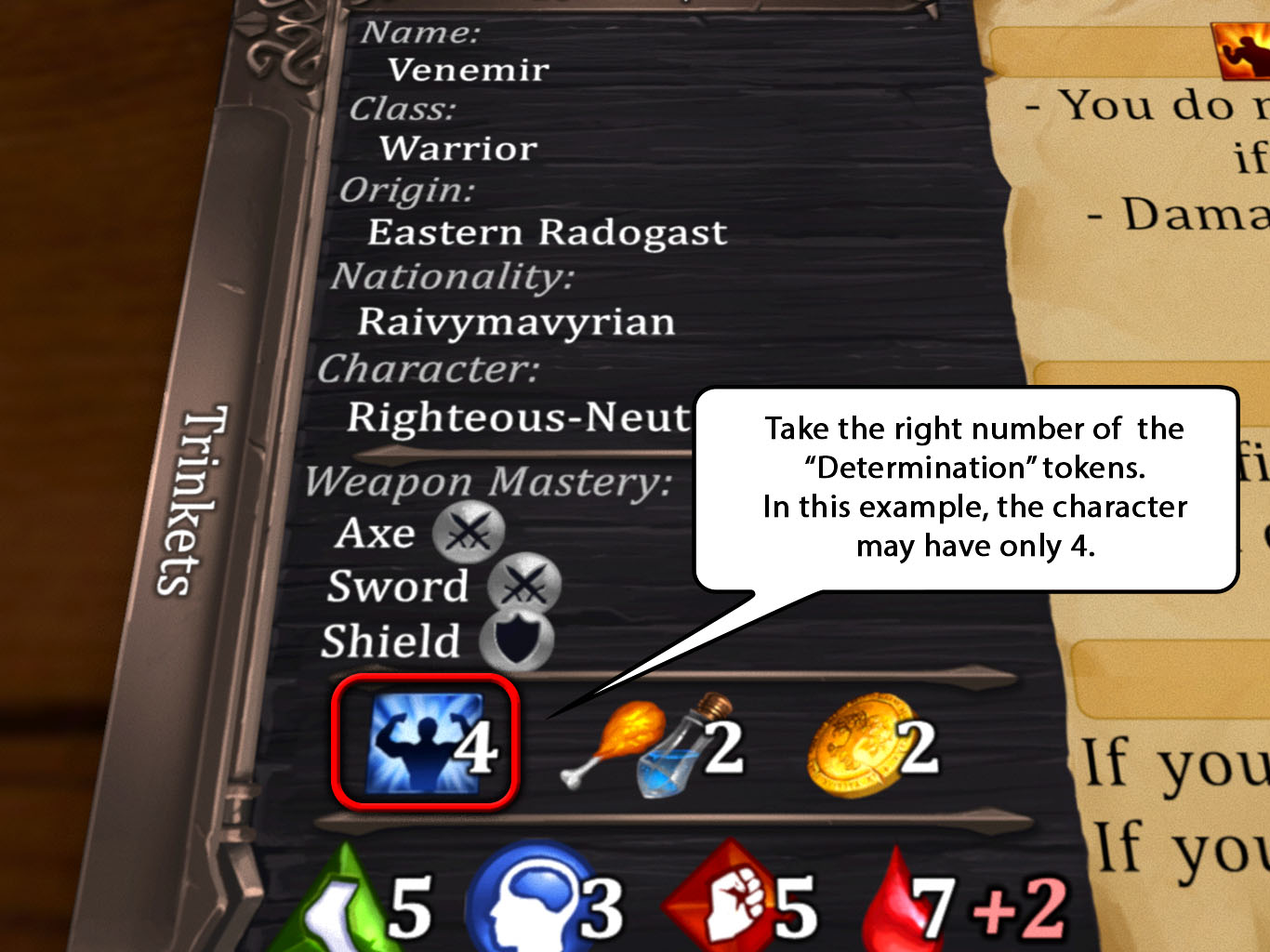
If you’ve been reading the previous posts carefully, you’ve probably noticed that we used a different word for this marker. We called it an “excertion point”. Finally we’ve decided to rename it to the “determination point”.
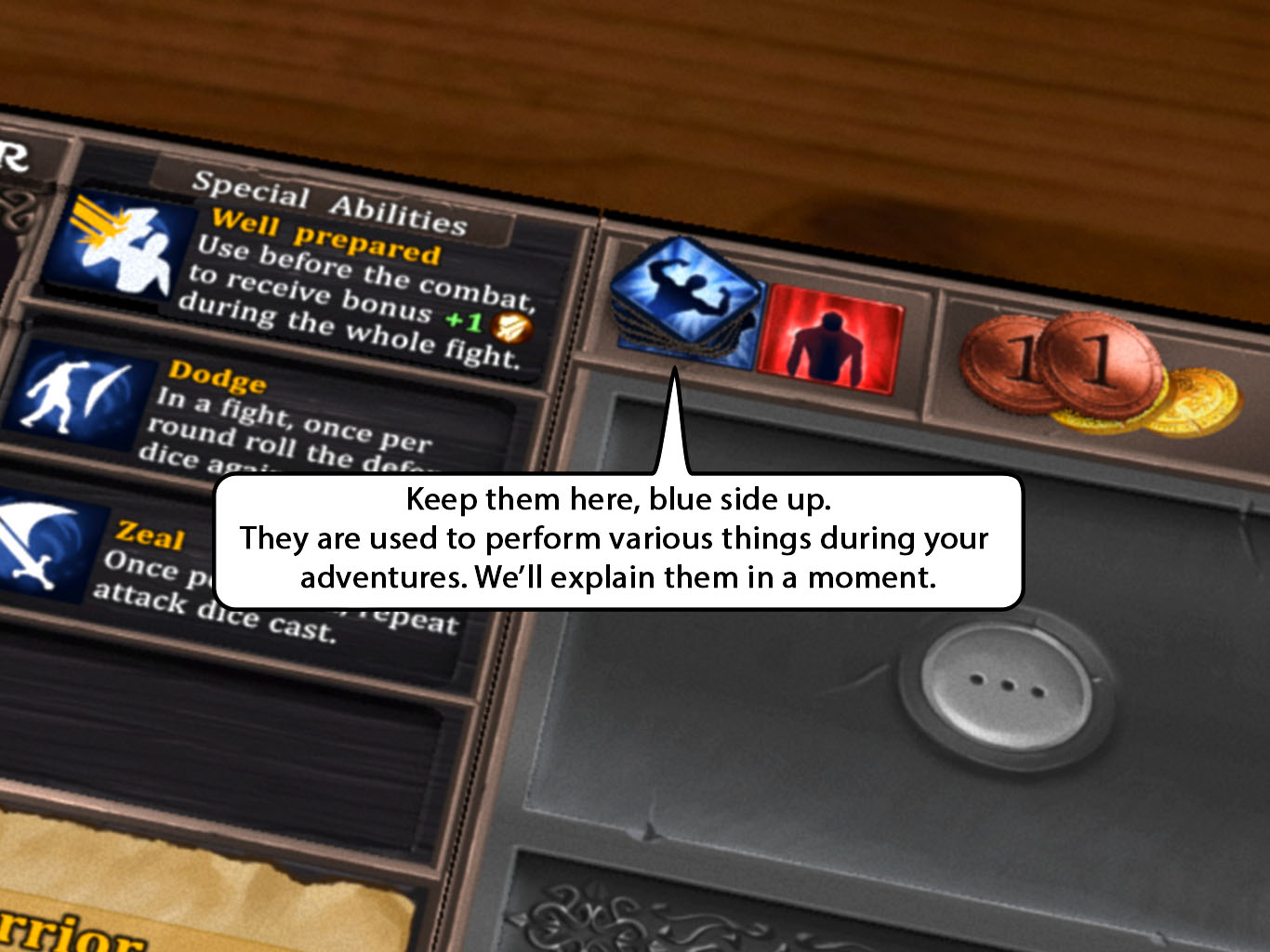
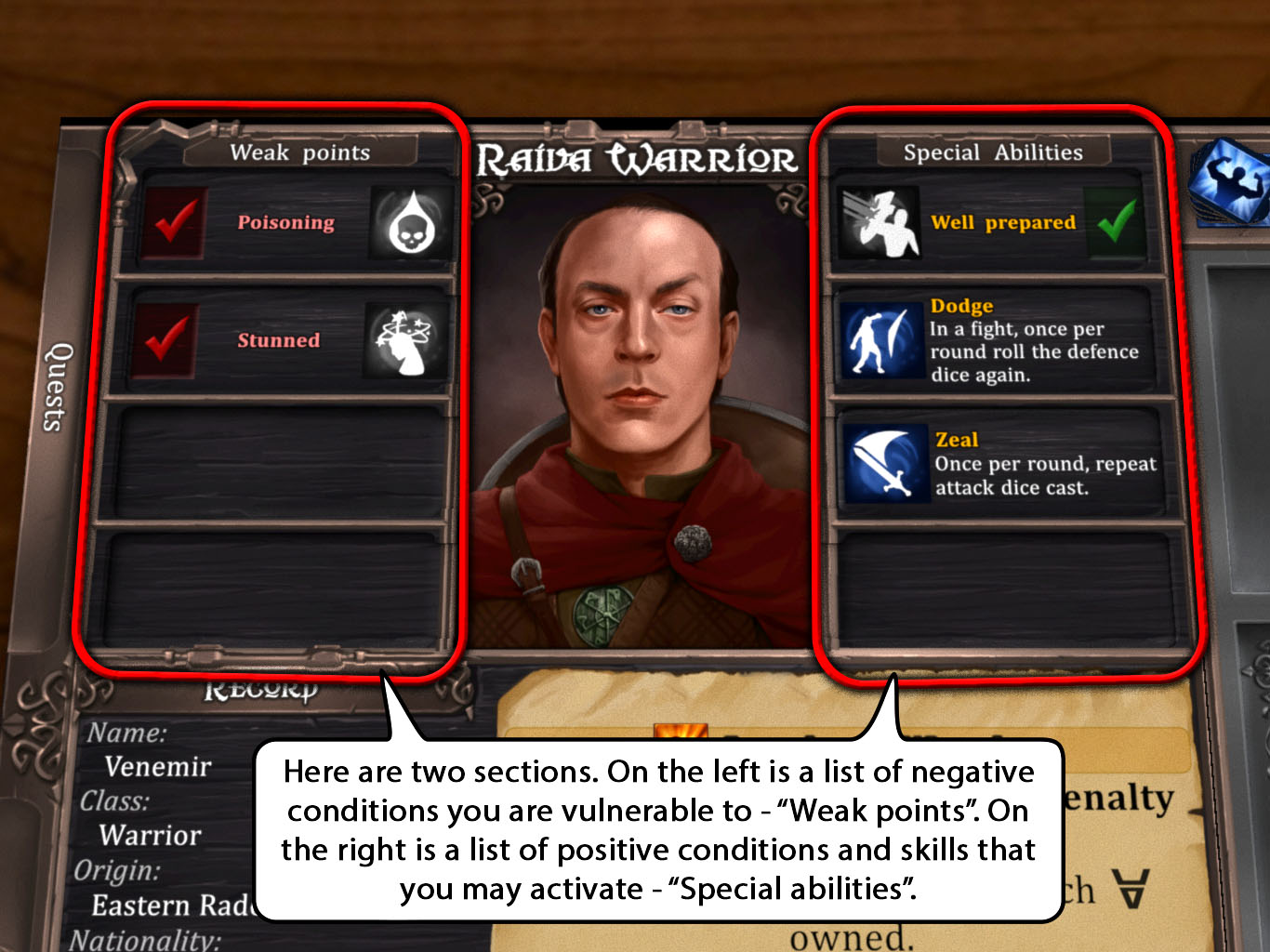
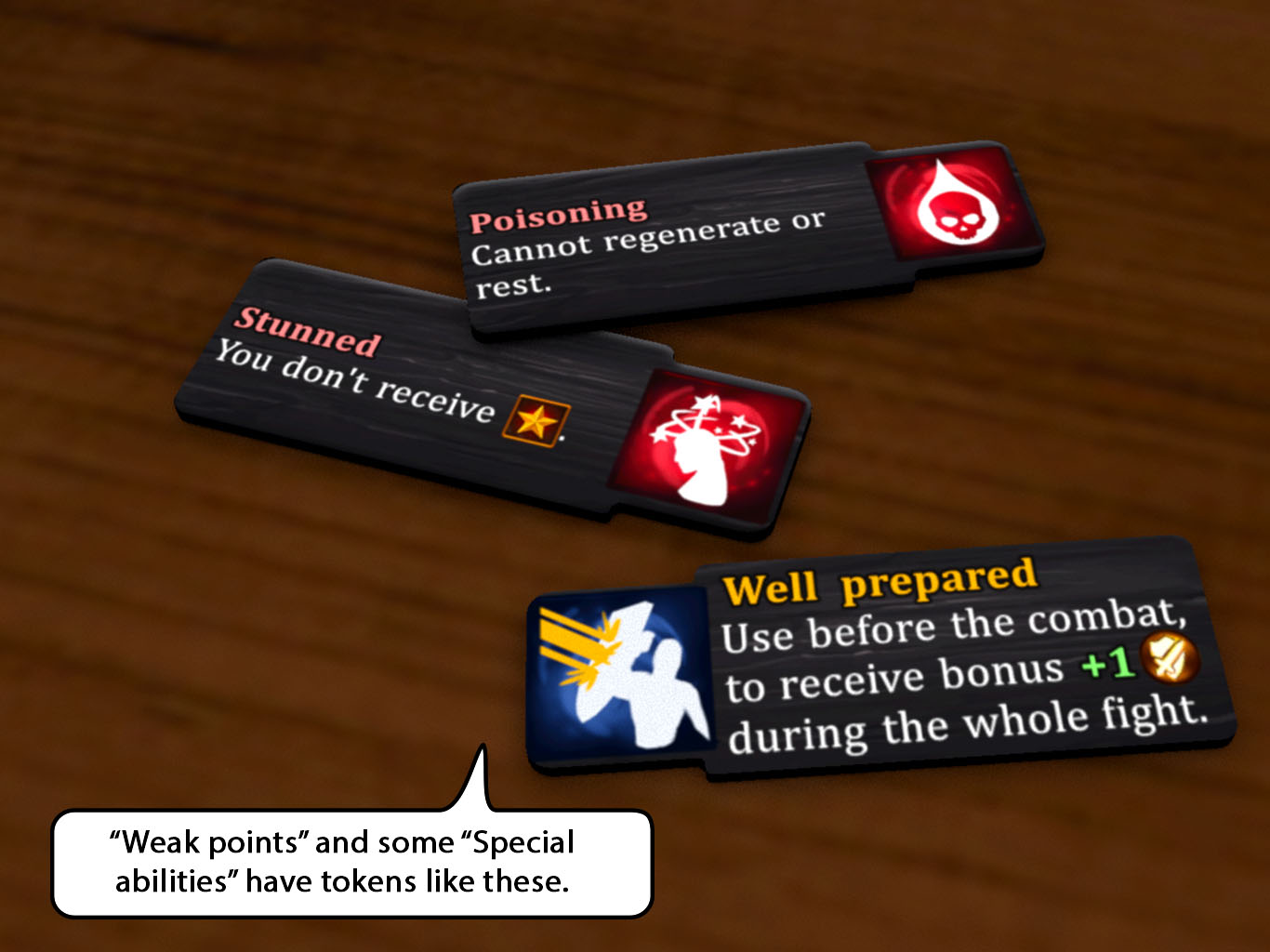
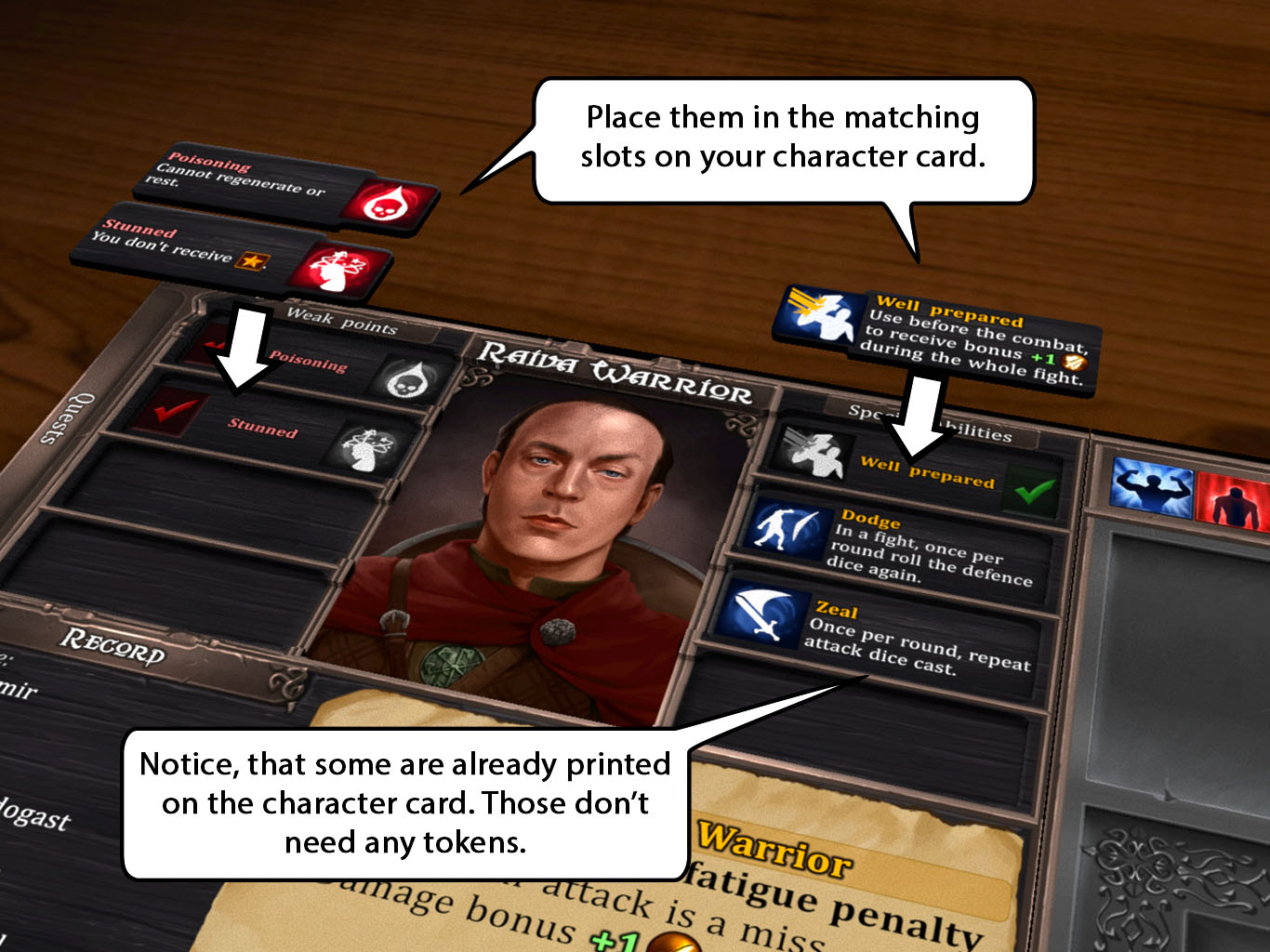
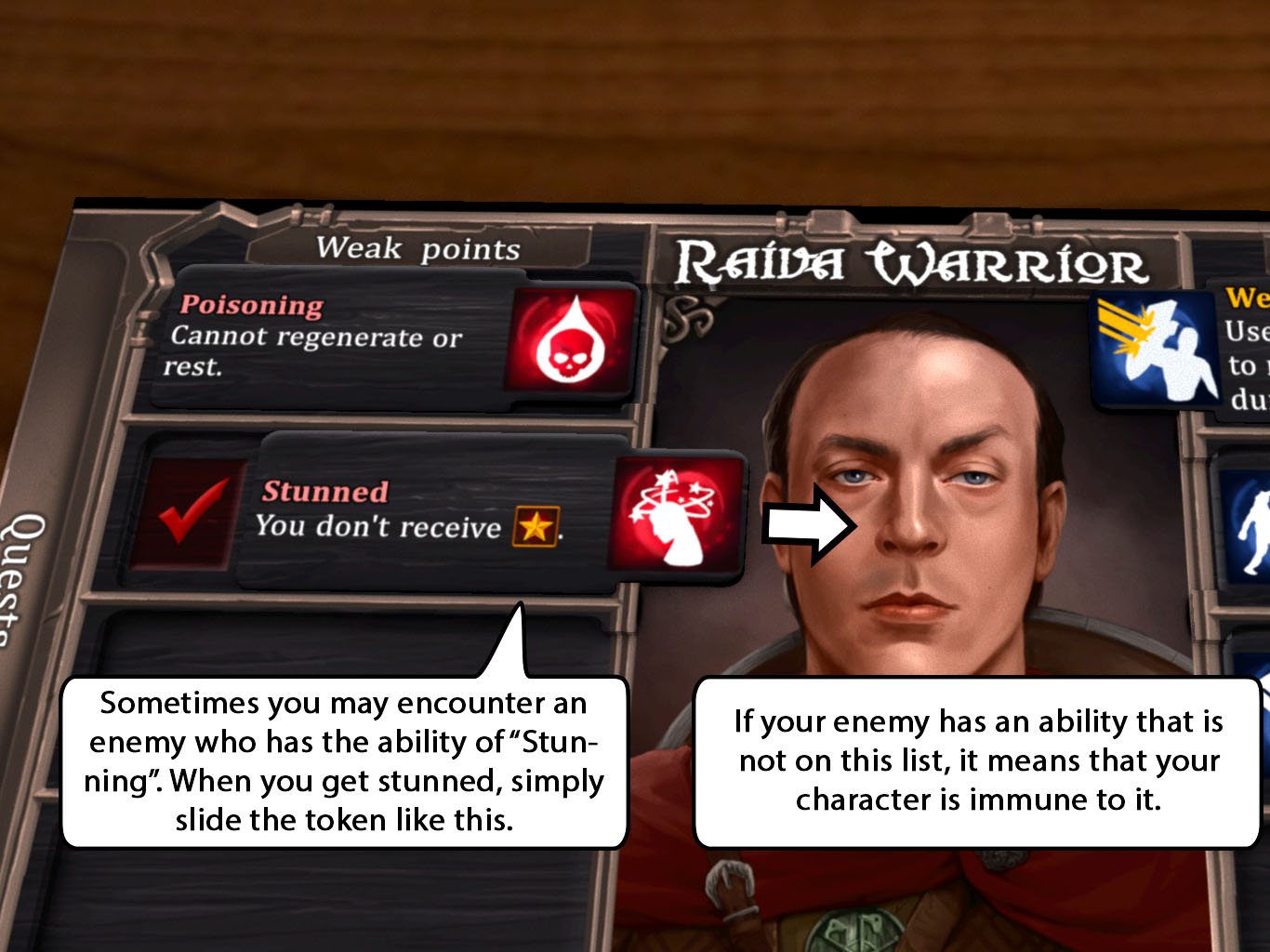
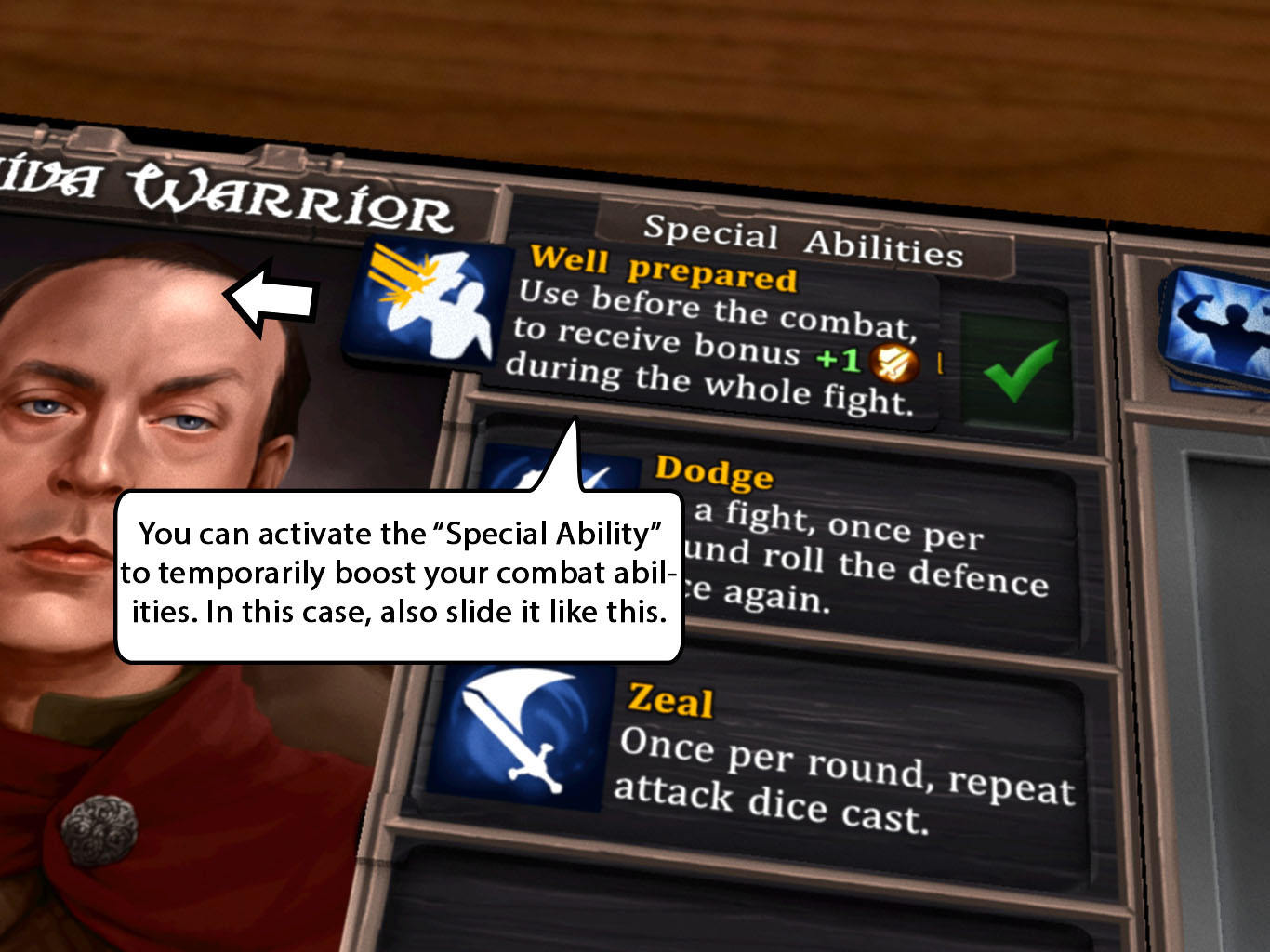
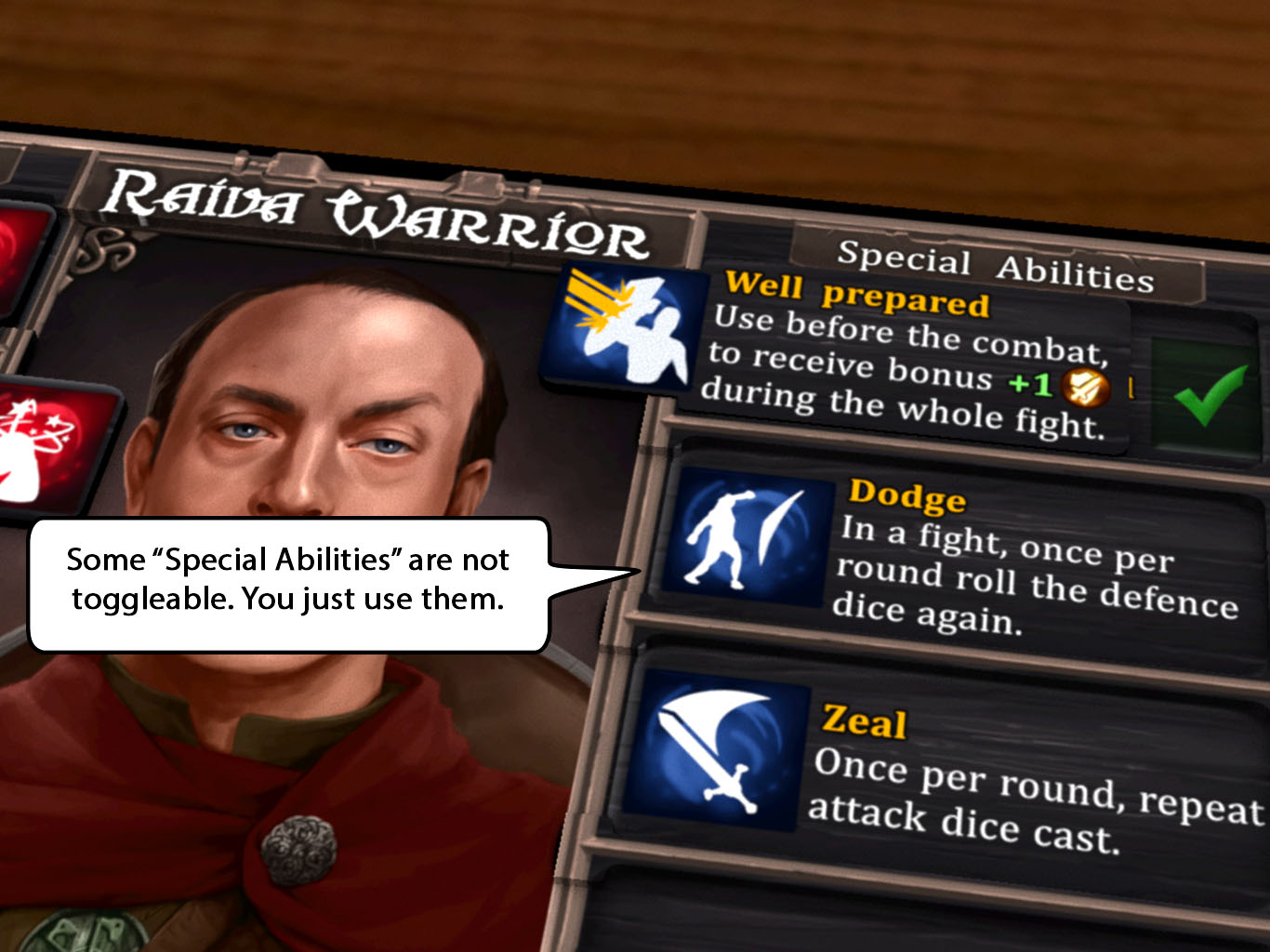
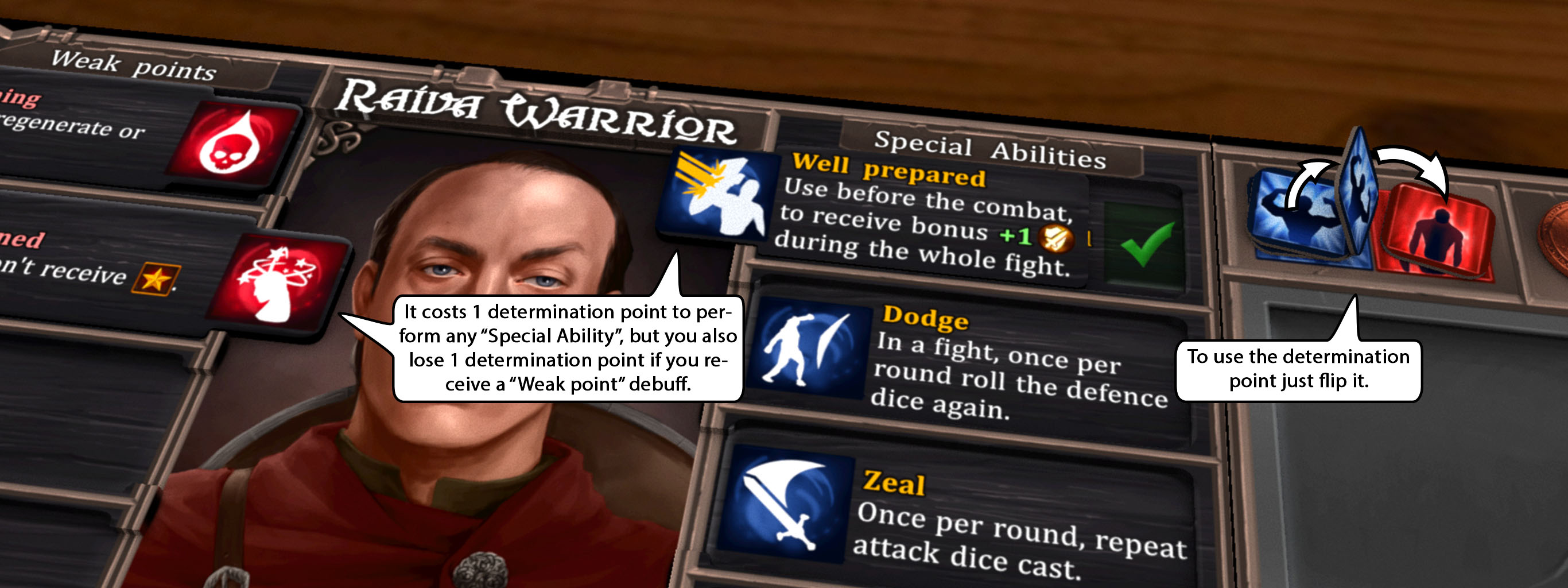
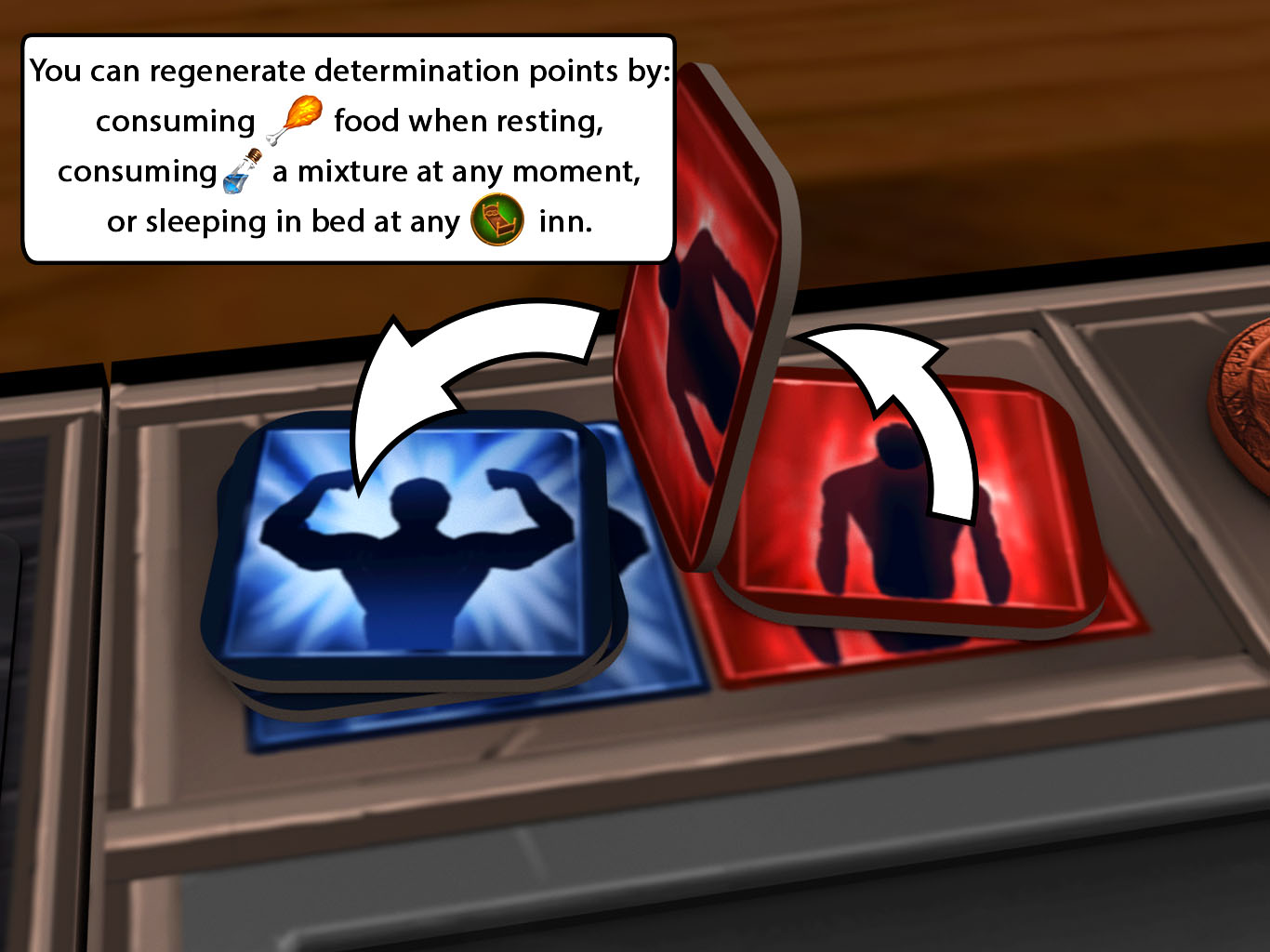
We have cut a few slides in here, as they focus more on the determination points than on the subject of this post. A few slides below, we’ll get back to the character card, and the initial setup.
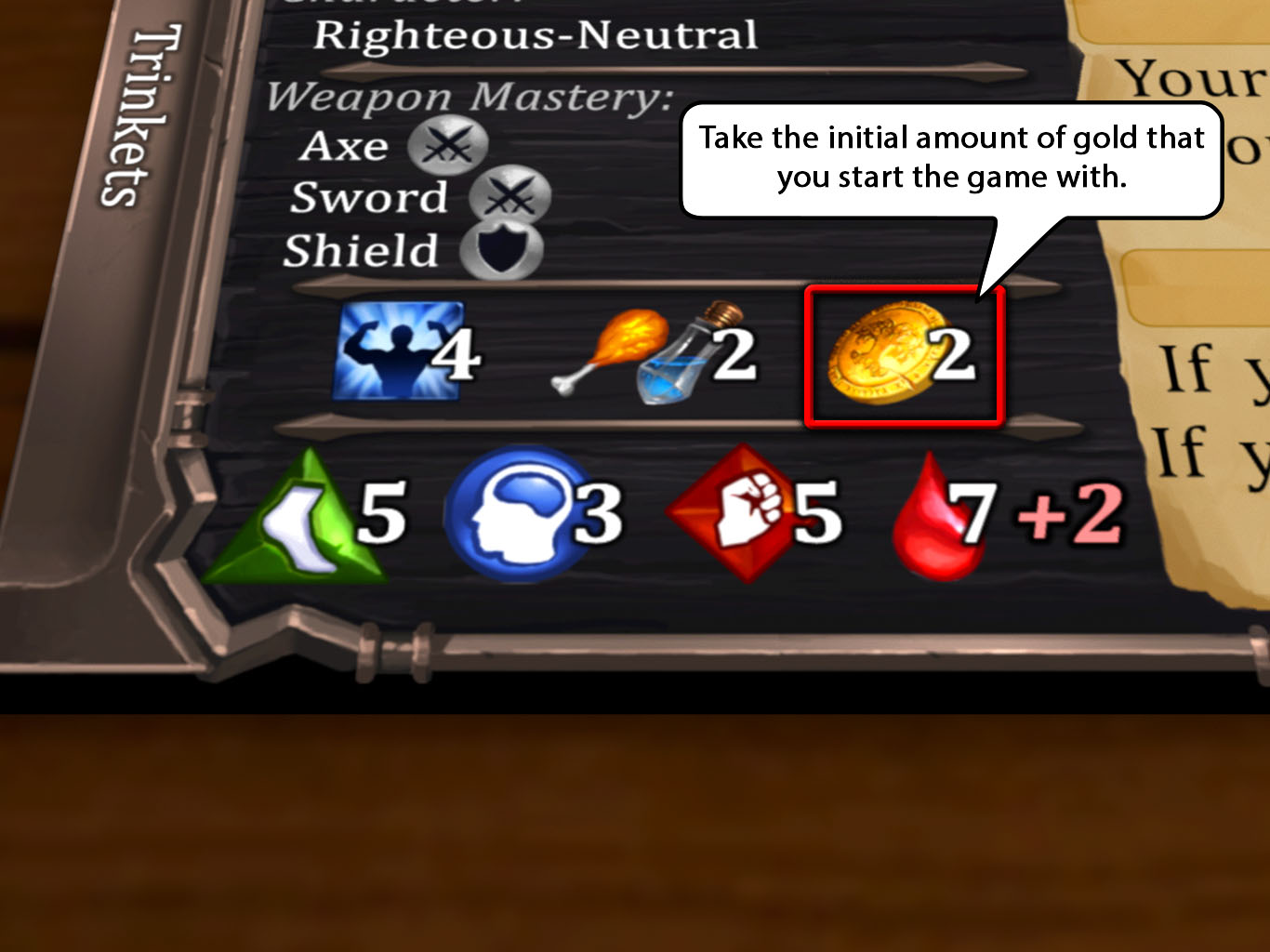
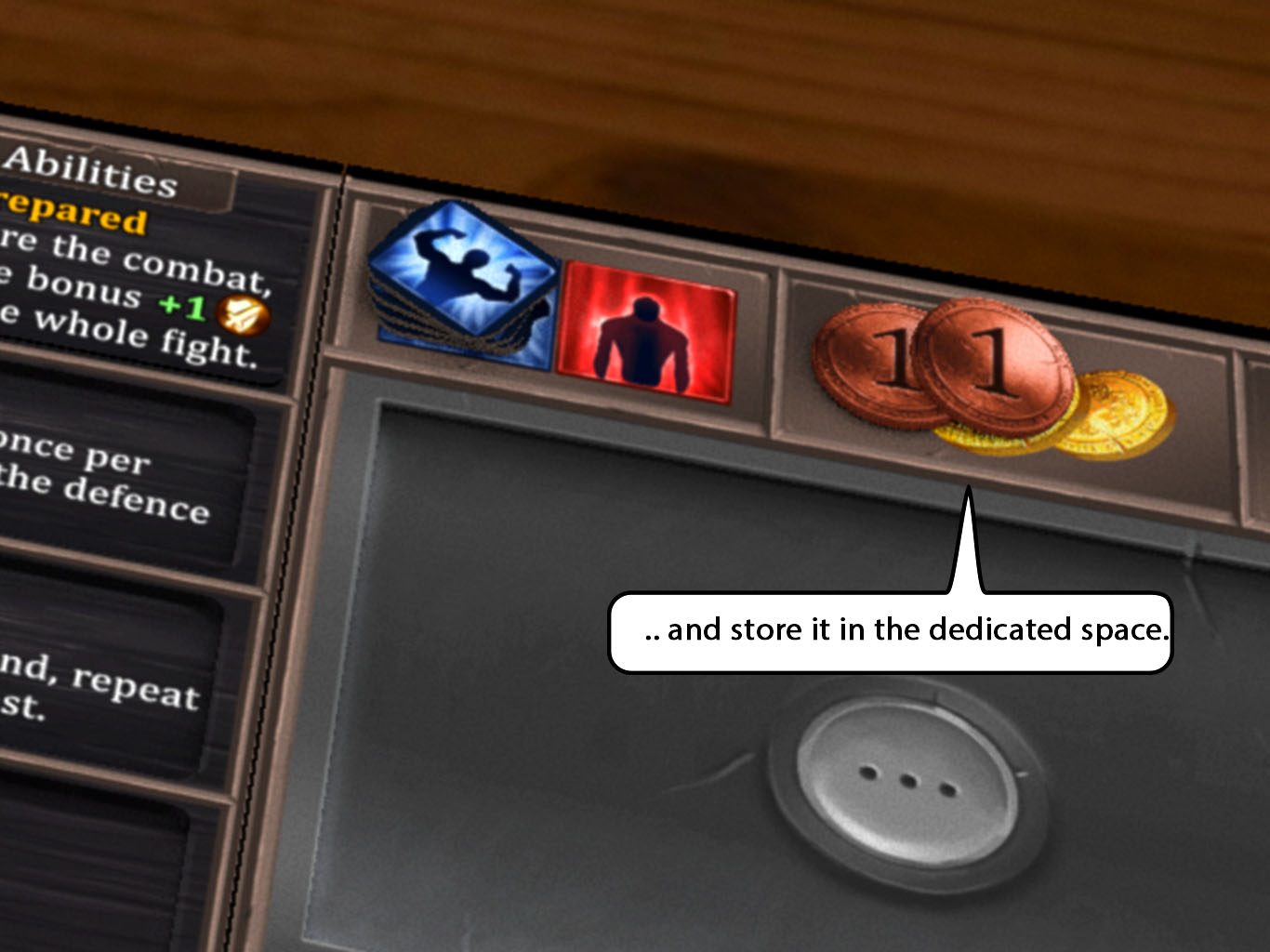
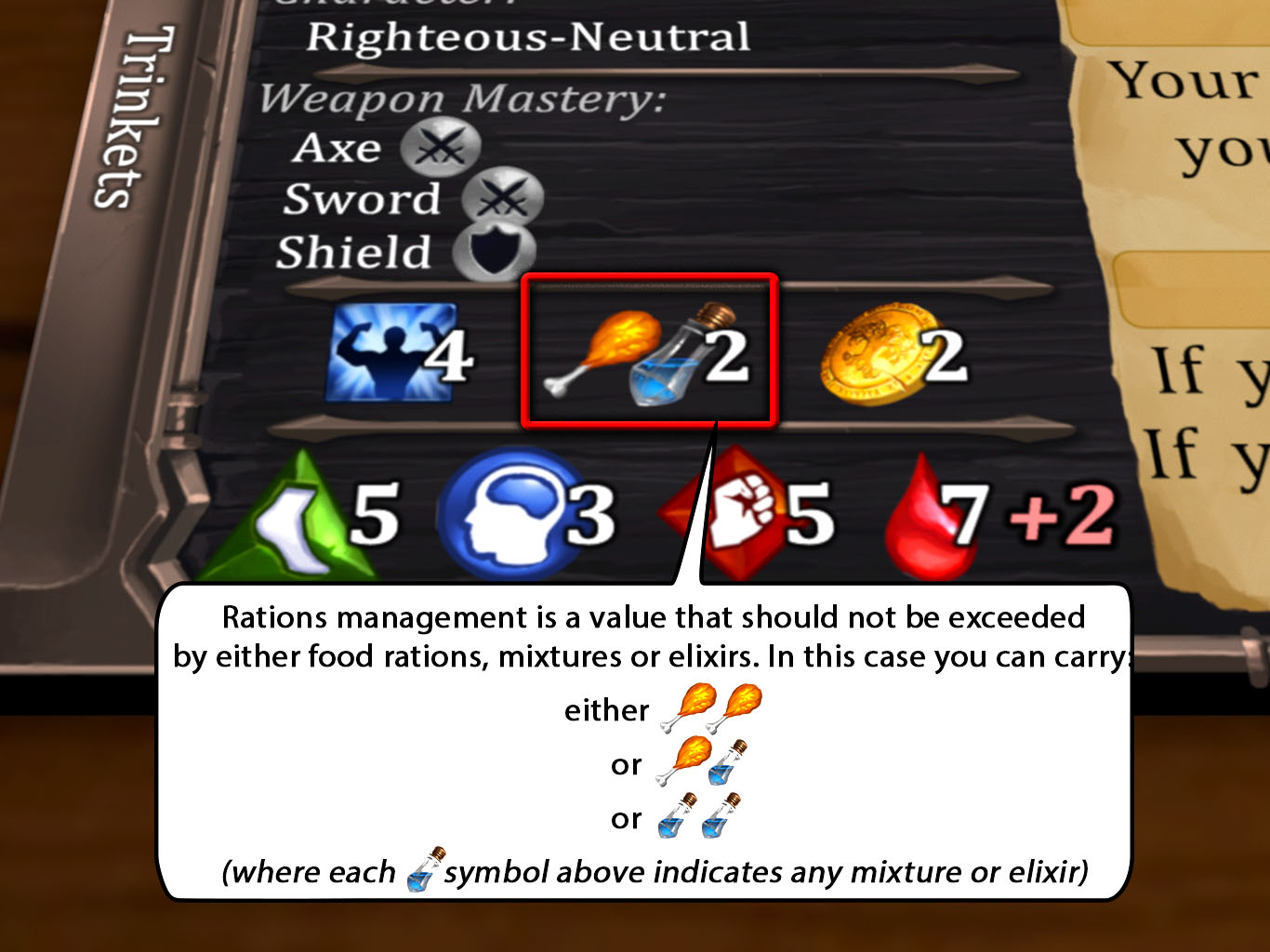
It’s a good moment to explain food rations in our game. They don’t represent the exact amount of food you have, but it’s also an abstraction of how well you can manage it. So the value shown on your character card is not only the amount of food you start with, but also the maximum amount you can ever have.
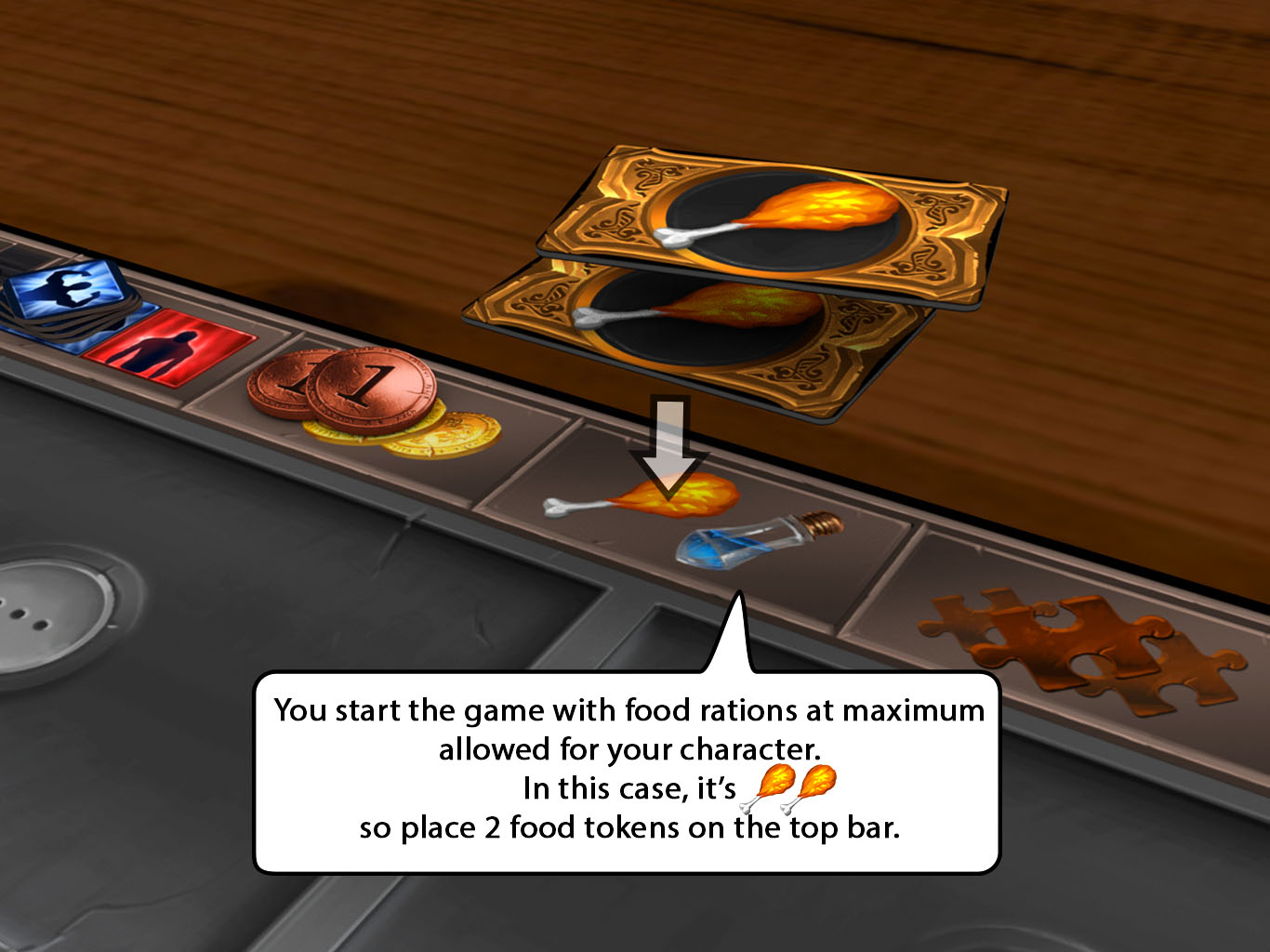
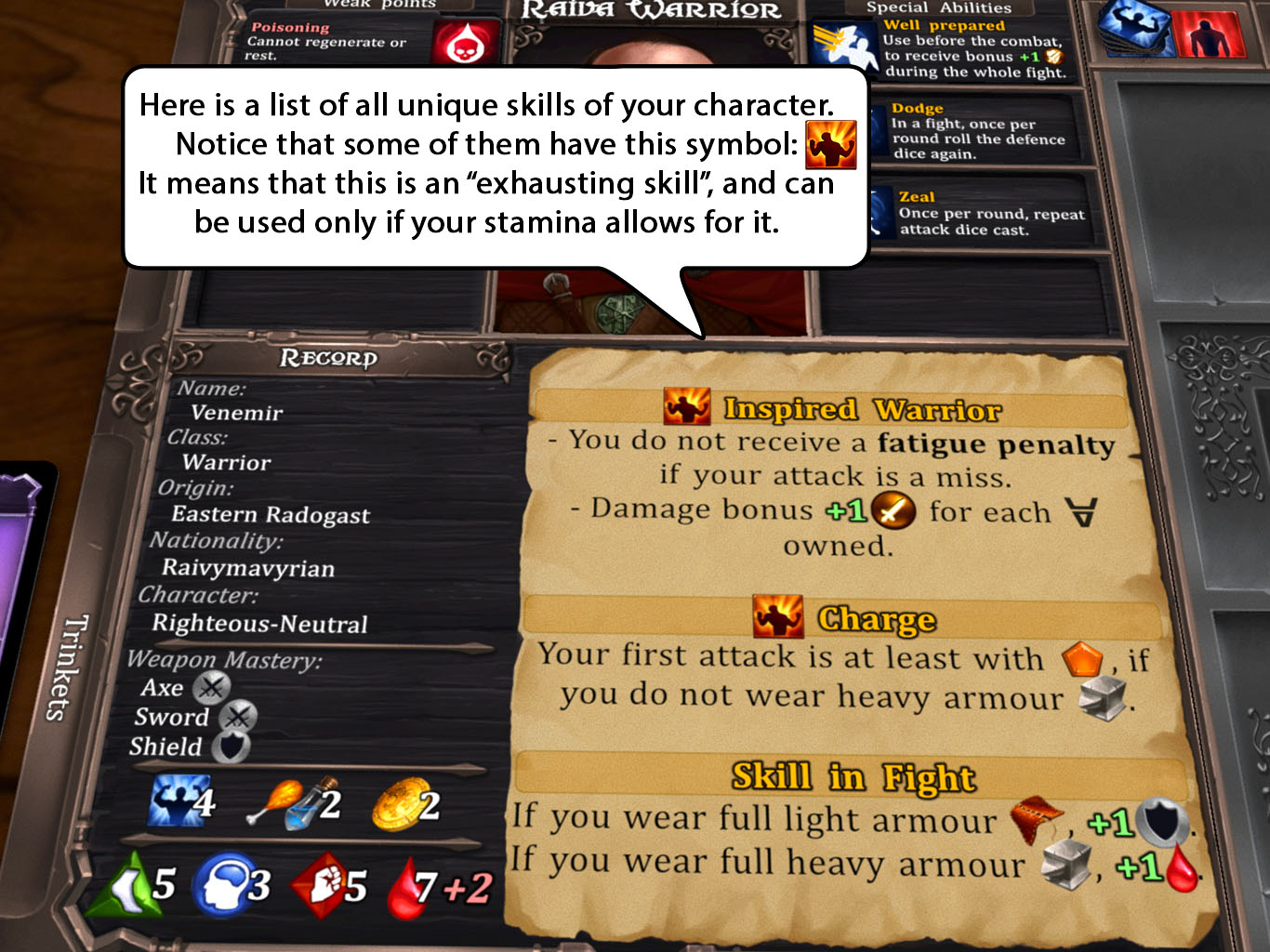
So… let’s interrupt our tutorial here and talk a bit about one of the available characters – the Raiva Warrior named Venemir.
The Raiva Warrior
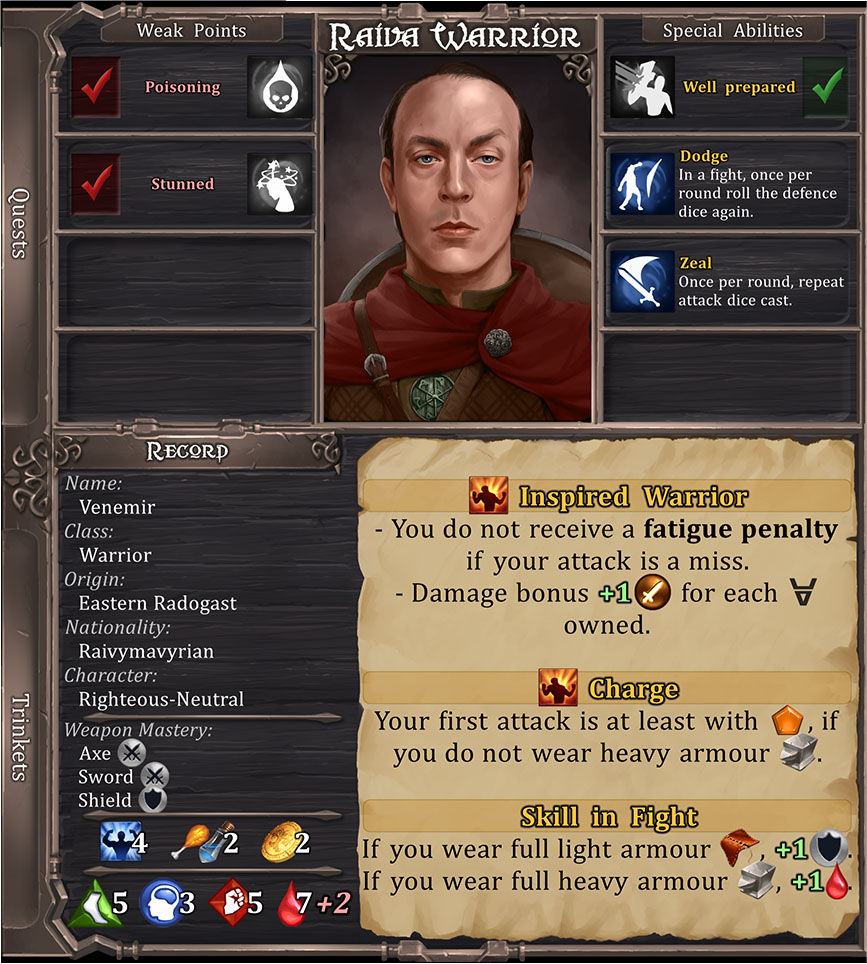
Portrait made by: Ylva Ljungqvist
Venemir is a true Raivymavyrian. He arrived in Jastarnia as a small boy and remembers neither his parents nor the reason they left him. His only memory is of a big palace he used to play in. He also never learned the story behind the kolovrat symbol tattooed on his right arm. He has always displayed exceptional skills in sword and axe fights, however, so it was natural for him to join the army and make a carrier there. Always in the first row, always for a good cause. He took part in all of the most important battles at the Peninsula and earned a reputation of a just and brave man. His name is already known well outside Radogast — who knows, maybe one day his destiny as a great king will be fulfilled?
Every character has a short background story that will be available in the “Story Book” attached to the game content. Obviously, such a story doesn’t have any effect on the gameplay, but it’s totally worth reading before you start playing, so you have a better view of who you are playing as.
If you go through his skills, you’ll figure out that there are a few optimal ways to evolve this character throughout your adventures. One way is to max out the agility. The “Charge” skill allows you to use the orange attack die as long as you’re not wearing heavy armour, while “Skill in Fight” gives you one more defense point if you’re wearing all body pieces of light armour type. Such a set bonus combined with this skill will easily give you the red defense die (the best die in the game). On the other hand, if you go in strength and wear heavy armour, you’ll increase your survivability. Those two skills make it look like the choice is obvious: you either go one or the other way. But in the real game, you’ll occasionally acquire some equipment which has such a great bonus that it may be worth to change your plans. For example mixing 2 types of equipment will make you stronger, even though some of your character’s skills become useless. There is also another thing worth considering. If you read the 2nd benefit from the “Inspired Warrior” skill, you’ll see that you get +1 damage bonus (for physical weapons) for every Snaaga Source that you own. A Snaaga source is an item (card) with a special symbol indicating that this item contains a source of special energy called Snaaga. With only 3 intellect you can carry max 1 Snaaga source. So you stand against a tough decision whether you should actually increase your intellect in order to be able to carry more Snaaga sources and greatly improve the damage you deal.
Lastly, great power results from the 1st benefit of the “Inspired Warrior” skill. You basically never get tired if you miss (which is a general gameplay rule). However, notice that this skill has an icon of an “Exhausting skill”, which means that it works only if your fatigue level is not too low. Some enemies and skills in the game have an ability to reduce the opponent’s fatigue during the fight. So once the Warrior’s fatigue is lowered, this skill will no longer work. In my personal opinion, finding a way to make him tired is a key strategy if you want to stand a chance with such a powerful character.
Each character has some additional benefits from using specific types of weapons. In this example, it is recommended to use an axe, sword, or a shield. Next to each weapon type, there is an icon of Attack or Defense. As we’ve explained in the previous chapter, collecting those points will raise the colour of the dice you fight with. (See the pic below).

Weapon mastery is a bonus meant to make you stronger for a reason. We’ve decided to add such a bonus to reduce the chance that your character will end up hilarious, like for example a strong warrior… with a magic wand! Being a warrior magician is not impossible, if you really want to, but to become powerful, you will have to work a lot harder than the naturally-gifted characters.
The Hunter
Silva Trenail – another interesting character.
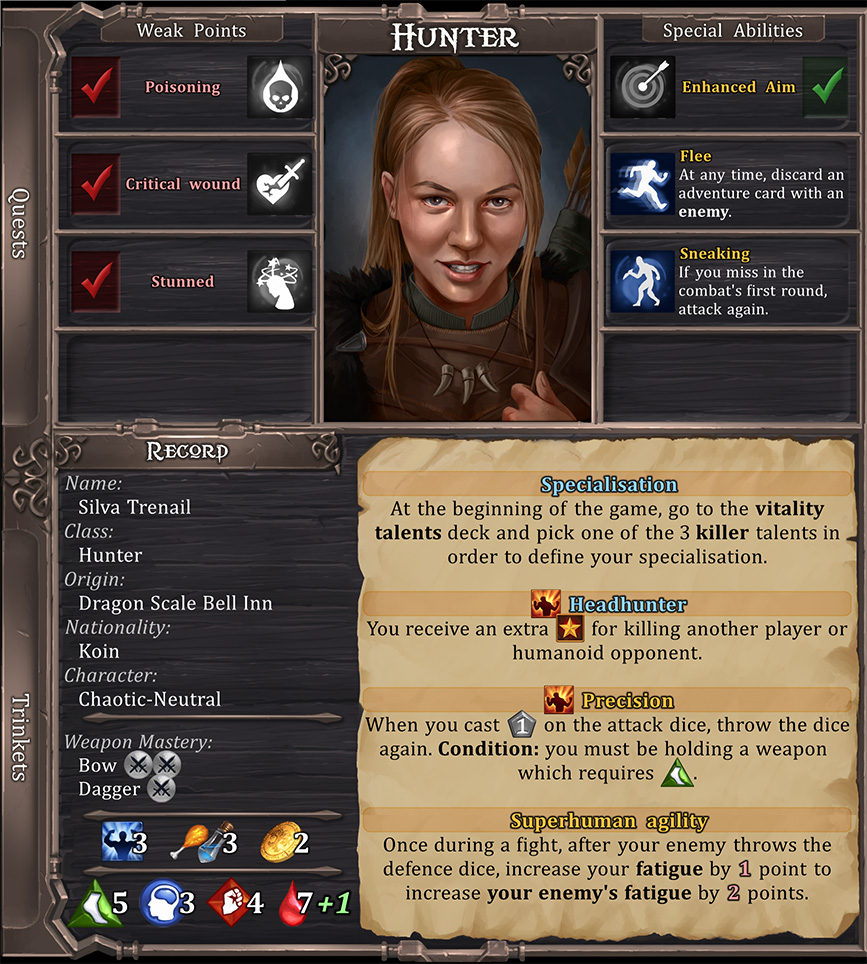
Portrait made by: Ylva Ljungqvist
Nearly everyone north of Kagaroth knows Silva’s father, Vran Trenail, a rich merchant and adventurer. Silva was his third daughter, and even though Vran did not live to have a son, Silva never gave him a reason to regret. Even as a child, she proved incredibly fast, agile and determined enough to win fights with older and stronger boys. While her sisters had dancing and singing classes, as expected from proper ladies, she spent her days in the armoury, or sneaked out to hunt alone in the Wilds. Once her father gave up on the idea of having her marry a local gentleman, he brought the best fencers of the Peninsula to take care of the practical aspects of her education.
Today, Silva Trenail is a hunter. A deadly skilled hunter. Don’t be distracted by her young age and innocently pleasant looks – even for a Koin girl. Lots of brave men lost their hearts to her. Literally. Not only men in fact – also dragons, giants and goblinoids. She knows how to sneak without a sound and she turned knife fighting into a fine art. Also, she is more than an extraordinary archer: she hits targets so distant that other hunters can’t even shoot an arrow that far. Don’t put too much hope in her scrupulous nature. If she has a contract to kill you, you’d better run from Jastarnia before she shows up to tell you about it herself.
In terms of skills, this character might not be as powerful as the previous one, but its greatest strength is quick progression. “Headhunter” gives you +1 additional experience point for each defeated humanoid or other player. Also, the first statement says that you begin the game already with 1 talent. Just to remind what a talent is – it’s a powerful skill obtained (on a separate card) when you reach the next level and spend both points on the same attribute, for example intellect. This character already begins with 1 out of 3 “hunter-talents” from the deck of vitality talents.
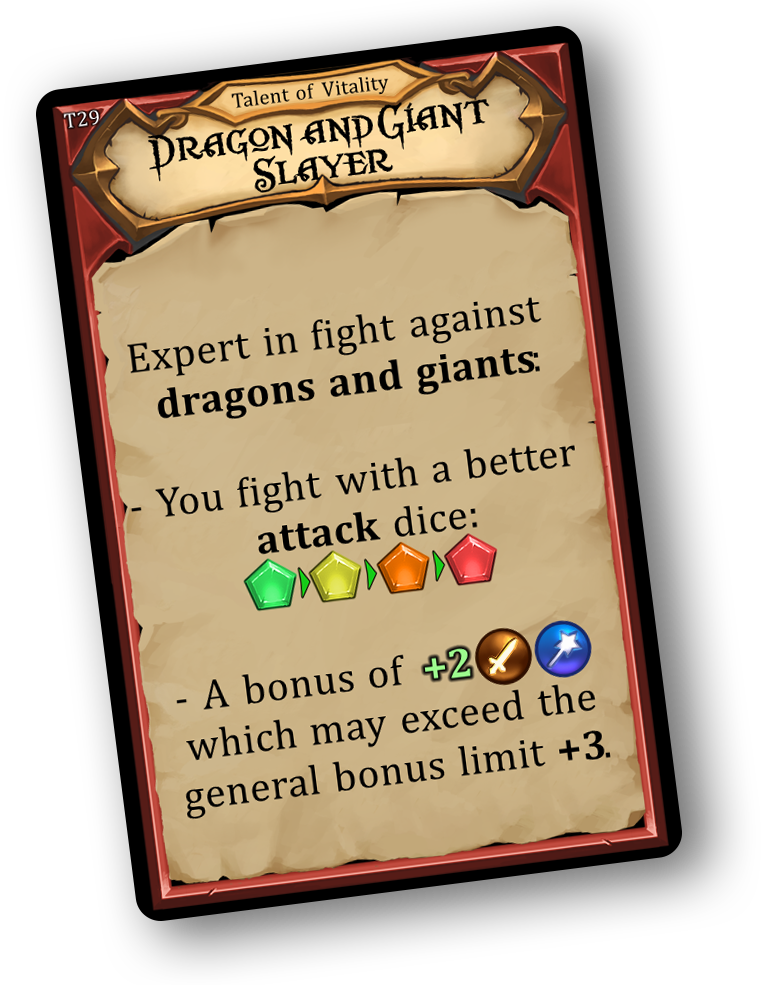
Those talents work only against a certain type of enemies, but they are really powerful. With such a talent, it’s much easier to grind your experience in regions where such a type of enemies occurs most often.
Another skill of this character – “Precision” adds a small chance to repeat your attack if you cast 1. It requires good memory and reflex from the player to react when 1 is rolled. To clarify, the main difficulty in this game lies for a player in having good memory and reflex to use the right skills at the right moment. Skills can never be used when it’s too late. It’s lost for your disadvantage.
The last skill of Silva Trenail, is “Superhuman agility”. You can sacrifice 1 point of your fatigue to increase the opponent’s fatigue by 2 points, but only once during the combat. If you remember the previous character – the Raiva Warrior – his strongest skill consists in that he never gets tired as long as his fatigue is maintained at the high level. Well… Silva Trenail is a rare character who can easily weaken him.
Now, before we end the today’s post, I’d like to mention the rule about selecting the character card. If you play solo, obviously you play whatever character you want, but if there are 2 players or more, there is a limitation in your choice. First, you flip all character cards face down, so nobody can see them. Shuffle them, and give 3 random cards to each player. Nobody can see the cards that you’ve got. Choose 1 of them and wait till everyone makes their choice. When ready, all of you show the characters you have chosen.
At this point, some people who had never played this game before may have a feeling that choosing the right character may give you an advantage over another player. In theory it does, but in practice it is not so straightforward. There are only a few skills on the character card, usually between 3 and 4. But when you collect some gear, trinkets, and talents, the list of skills easily goes over 10-12. The situation is changing constantly. If at some point you feel that your opponents became way stronger then you, then you should probably change the strategy. Avoid getting close to them, and aim to defeat the final boss as soon as you feel ready for that.
So this is it for today. We’ll reveal some more characters in the next development diary posts. We hope that you’ll stay with us, and remember to subscribe the social media to be up to date with the new posts.
